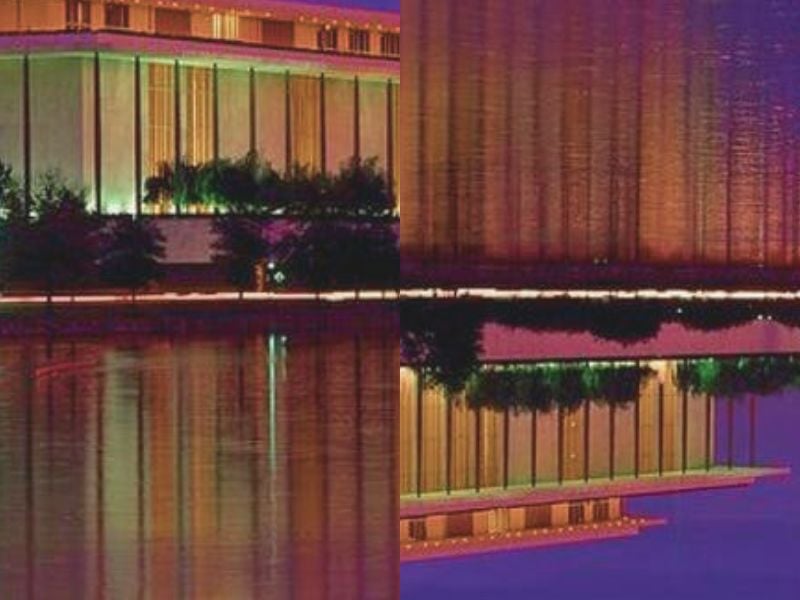Sheer madness is an apt description for what is going on at the Kennedy Center these days, so it was fitting that Shear Madness, the long-running whodunit, was the show that led me to return to the venue last week for the first time in months.
Like many arts lovers in Washington, DC, I’ve been grappling with an existential question since February: Whether to attend the Kennedy Center or not. On February 12, just three weeks into his second term in office, Trump fired all 18 Democratic board appointees at the traditionally bipartisan institution and replaced them with his own political cronies, who immediately elected him chairman of the board. Because, as the new leader of the free world, a top item on his political agenda was deciding whether DC audiences will get to see Legally Blonde next year?

This move immediately sent DC’s artists and audiences into a tailspin. How should we react to this unprecedented political interference with the crown jewel of our arts scene?
Politics and art have always collided in Washington but even in divisive times, institutions have worked hard to keep that involvement bipartisan. Kennedy Center board appointees have always included Republican and Democratic political figures, The Shakespeare Theatre Company hosts two annual events featuring politicians, and up until his death in 2016, Supreme Court Justice Antonin Scalia regularly attended theater and opera with Ruth Bader Ginsburg (ideologically opposed but culturally aligned) at venues across DC.
But now that bipartisanship was dead at the Kennedy Center, and worse, that it was smashed under the boot of Trump’s announced goal of eradicating Diversity, Equity, and Inclusion policies, should DC’s arts community continue to support the Kennedy Center? Or, in doing so, are we implicitly condoning an administration whose actions are the antithesis of the Kennedy Center’s very mission of providing world-class art to all Americans? For me, this question really hit home since I have a lot of friends who worked at the Kennedy Center. While I didn’t want to support Trump’s effort to strip the Center of inclusion, I also knew that a mass boycott would result in lost jobs for many of my friends and colleagues. So, what to do?
In one of the strangest twists of fate I’ve experienced since becoming a parent, my 15-year-old daughter made that decision for me last week. My daughter, whose dubious life choices typically veer toward the dangerous and illegal, asked me to take her and her boyfriend to see Shear Madness, the interactive mystery play that has been playing at the Kennedy Center since 1987.
“You… want to see a play?” I asked, just to make sure I was hearing her correctly. (This is the child who, since birth, has resisted all forms of culture, despite my best attempts.) It turns out it was her boyfriend’s idea. He had seen the Back to the Future musical at the Kennedy Center and thought it would be fun to get all dressed up and see Shear Madness. (Bonus points, boyfriend. You have earned serious bonus points.)
It took me about ten seconds to mull over the ideological implications of attending the Kennedy Center before jumping into my car with the teens. Politics be damned. My daughter asking to see a play with me? This was a parenting win for the ages. “Get in, kids, we’re going to the Kennedy Center!”
My daughter has little idea that her innocent night out brought us into the crosshairs of the largest cultural shift at an American arts institution in decades. Our trip to see Shear Madness happened on the very day that the Center’s new leadership fired a majority of its DEI team, the program specifically tasked with diversifying the Center’s programming. That loss was fresh on my mind as I stepped into the Center’s Grand Foyer, leaving me feeling like the Kennedy Center was no longer the institution I had long known and loved. I decided to approach my visit like a sociological experiment. How would it feel to spend time in this brave new world of artistic repression? Would the changes be noticeable, or would everything seem business as usual?
In some ways, stepping into the Kennedy Center felt like coming home. But not like returning to your cozy home after a long day of work. More like nervously inspecting your house after a tornado hit it while you were on vacation.
I chatted with old friends who were there to review Twyla Tharp Dance Company while my daughter canoodled with her boyfriend on the balcony. The friendly box office agent smiled while handing me my tickets, and patrons filled the gift shop. But was it my imagination, or was the smile on that agent’s face a bit… forced? Yes, looking just slightly beneath the surface, there were clear signs of Trump’s influence, starting with the straws.
Dear readers, Trump has BROUGHT REAL STRAWS BACK to the Kennedy Center. I know this because at every bar in the Center, there is now a giant sign next to the cash register proclaiming (in all caps, with the exclamation mark) STANDARD STRAWS NOW AVAILABLE! Because Trump knows that what every arts lover really wants from a night out is a chance to suck through a plastic straw. And god blessed America.
Moving beyond the straws, I noticed that the red-carpeted Grand Hall seemed emptier than usual. The thin crowds were dominated by older white patrons heading to the two mainstage productions programmed that evening: Twyla Tharp and the ballet Coppélia.
And then I noticed the teenagers. Hordes of teenagers on spring break trips from across America, all wearing the lanyards of various tour groups, and many sporting MAGA hats. Out of curiosity, I followed one group of raucous teen Trumpsters down the Grand Foyer to the famous Kennedy bust, where they excitedly snapped photos. You’ve never seen so many young Republicans so excited to see John F. Kennedy.
Most of these tour groups, it turned out, were there to see Shear Madness, so we all took the elevator up to the Theater Lab, the teens (mine included) raucously knocking into each other and engaging in more teenage canoodling.

Even though I’ve been to the Kennedy Center dozens of times, it had never occurred to me to see Shear Madness. As the longest-running show in America, it was never a pressing need, the kind of thing that is always there, so you never actually see it. But now that I was there, I was actually excited for the experience.
About halfway into our elevator ride, surrounded by tourists from Louisiana and Missouri (according to their lanyards), it occurred to me that DC’s tourism industry is probably why Shear Madness has been playing at the Kennedy Center since 1987. It’s the perfect way to end a day visiting DC’s major monuments. White House? Check. Jefferson Monument? Check. See a play at the Kennedy Center that will entertain you but not make you think too much? Check.
After hearing Trump declare that he wanted “less woke programming” at the Kennedy Center, I had been scratching my head. What do “non-woke” shows even look like? Isn’t provoking thought and pushing boundaries kind of the whole point of the performing arts?
Well, folks, with Shear Madness, I think I found a perfectly non-woke play. The plotline — a murder is committed at a hair salon, leaving everyone in the salon a suspect — would have a hard time offending anyone. This is Scooby Doo– or Jessica Fletcher–style murder, the kind that somehow makes you feel all cozy inside even though some poor sap offstage just bit the dust. It is safe to say that there is nothing in Shear Madness that will trigger Trump’s censorship detector and that the show will remain a balm to tired Midwestern tourists for the next four years.
The one slightly DEI element in the show is the character of Tony, the gay barber. But Tony is written in the way many gay characters were written in the decades when homosexuality was either something to be ignored on the stage or exaggerated into a caricature and therefore made palatable. Tony is every exagerrated gay stereotype: He is always horny and constantly flirting with the straight beefy cop. He is loud and effeminate. He loves Carol Channing and community theater. He gives up glitter for Lent and shops at Joann Fabrics closing sales. You get the picture.
“Do you know how to whistle?” Tony asks the beefy cop at one point. “It’s easy. Just put your lips together and blow.”
“Get back in the closet!” the cop replies.
(Cue raucous laughter.)
I’m not mocking the show to minimize it in any way. I actually had a really good time, and the actor playing Tony was a hoot from start to finish. There are many reasons that Shear Madness is the longest-running show in Kennedy Center history, and while the appeal to tourist groups is among them, it wouldn’t have lasted this long if it weren’t anchored in a clever script and engaging execution.
Written in 1963 by the German writer Paul Pörtner, Shear Madness began as Scherenschnitt oder Der Mörder sind Sie before its English translation became a DC staple. The play is most notable for its unique interactive element. Act Two opens with the lights up on the audience, who are invited to interrogate the cast and vote to determine who the villain will be each night. Even the jaded teens in the room were gleefully shouting out theories. Fun!
In addition, the script is continually updated to reflect current events and politics, making it a hit with audiences already on a tour of the nation’s political capital. The version that I saw had at least three Elon Musk jokes. One joke aimed at former President Joe Biden got a huge laugh from the MAGA crowd: “She used to babysit Joe Biden. That’s how old she is.”
I really enjoyed my night at Shear Madness, but I had the uneasy feeling that I was watching the kind of vanilla, non-woke, non-envelope-pushing content Trump has in mind for the Center’s future programming. Because, while I do enjoy an occasional night of silly fun, I think most people who attend the Kennedy Center want a combination of entertainment and growth, whether that be an opportunity to introduce your kid to a form of art, or to challenge yourself to see the world through a new lens.
As journalists are wont to do, I did a bit of snooping after the new administration took over, reaching out to friends and contacts who work at the Center. The mood behind the scenes was grim; everyone worried about losing their jobs and terrified to say the wrong thing to a journalist. One person, who I believe has since resigned, confided over Signal (Pete Hegseth’s favorite app), “If you had told me six months ago that I would be working for the Trump administration, I would have told you you were crazy. This is not what I signed up for.”
As with the rest of America under Trump 2.0, uncertainty seems to be the order of the day at the Kennedy Center. The new leadership, when I spoke to my sources a few weeks ago, was not communicating with staff and somehow also micromanaging them. This lack of top-down communication put seasoned staffers in the tricky position of fielding questions from disgruntled patrons and left them unable to respond to public frustration over cancelations that occurred in the first weeks of the Trump takeover.
So who are these new leaders who will decide what content is non-woke enough to pass muster at Trump’s Kennedy Center? Will it be Roma Daravi, the News Max pundit recently appointed as VP of communications, whose Instagram page is basically a MAGA altar? Richard Grenell, the interim executive director, who until last month had no association with the arts and who is now making headlines for his belligerent replies to emails, or Donald Trump himself, whose favorite musical is Cats because ballerinas look gorgeous in tights? Call me crazy, but none of these people seem particularly qualified to curate art at an institution whose mission includes educating young people and making the arts accessible to all Americans.
Back in the day, I myself was an angsty teen who visited the Center on a school field trip from the Midwest (Ohio, represent!). I traveled with the classical a cappella group from my high school. We thought we were huge celebrities because we actually got to perform at the Kennedy Center, and my mom bragged about it for years. One of my most cherished artistic memories is rehearsing “Ave Maria” in a small room before we performed. We held hands and closed our eyes, and let me tell you not a teen had a dry eye when the final harmony rang out in that tiny rehearsal room. I still get shivers remembering that early encounter with the power of music. It was possibly the closest I have ever felt to a higher power.
Flash forward a few decades and I was back on a Kennedy Center stage to introduce a Hamilton sing-along I organized on the Center’s Millennium Stage at the height of Hamilton-mania. This time, it was my kids who felt like VIPs when they were ushered past crowds of Hamilton fans to front-row seats.
Since then, I have attended many events of different types at the Kennedy Center, each one bringing together people of varied backgrounds who all shared a love of art. There was the time in 2017 that I got to cover the inaugural performance of the Center’s Hip-Hop Initiative that featured Jason Moran, the Center’s Artistic Director for Jazz, on a Steinway Grand, and Q-Tip, Artistic Director for Hip-Hop Programming, on a turntable. Together, they created a mind-bending series of jazz and hip-hop mashups before the public was invited to a free dance party where Q-Tip made a surprise appearance as DJ and turned the Kennedy Center into DC’s hottest nightclub. It was a party for the ages.
And I have never enjoyed a more glorious clash of cultures than the night that The Grateful Dead’s Bob Weir performed at the Kennedy Center with the National Symphony Orchestra, attracting an audience of patchouli-scented hippies on the same night that the Broadway Center Stage production of Guys and Dolls performed for the Center’s most esteemed board members and donors. The audiences for the two shows intermingling on the red carpet was a chef’s kiss juxtaposition of cultures, with tuxedoed doyennes of the arts bemusedly observing tie-dyed Grateful Dead fans and sipping champagne on a balcony that smelled suspiciously like weed.
None of these events will appeal to everyone, but each of them will appeal to someone. I, for example, have never been to a drag show at the Kennedy Center, or an opera for that matter. They just aren’t my thing. Or maybe, like Shear Madness, the opportunity just hasn’t come up yet. But I’m glad they are there for the audiences whose lives they will enrich. Claiming that an art form is dangerous and needs to be banned, as Trump has repeatedly said about drag performance, is a tired trope of authoritarian regimes, antithetical to democratic principles, and an excuse to manufacture outrage among Trump’s constituents.
So back to the original dilemma this essay is meant to address: is it in the best interest of DC’s arts community to support or to avoid Trump’s Kennedy Center? As I’ve been writing this essay, I’ve been grappling with my own feelings. I want to say that I’ll continue to frequent the venue, because a mass exodus of patrons and experienced staff could threaten the long-term sustainability of the Kennedy Center. But the truth is that the news coming out of the Center now makes it hard for me to feel good about that decision. Richard Grennell’s vitriolic email responses, Trump posing on the Opera House balcony like it’s his own personal fiefdom, the firing of skilled professionals for ideological reasons: All of these things make me feel like it would be a violation of my own core beliefs to ignore all of that and attend.
There are plenty of other performing arts venues in DC, and I suspect those places will see an uptick in attendance as patrons consciously avoid the Kennedy Center. Why deal with a political shitstorm when you can go somewhere else and just focus on the art? But while other venues in town offer comparable opportunities to see high-quality art, none of them can replicate what happens at the Kennedy Center, because no other institution in America has the Kennedy Center’s specific mission to produce art, support artists, and provide arts education to ALL Americans. If we lose the Kennedy Center, we lose something truly unique and unreplicable.
So, it is with a heavy heart that I admit that it will be hard for me to commit to attending the Kennedy Center over the next few years. And if I do go, I will be there to support the artists and the staffers. And I’ll be there for my daughter, who deserves access to art and culture for decades to come. And if she wants me to take her to a drag show or an opera someday, I will jump at the chance to broaden her worldview. I just hope that a future Kennedy Center will be able to offer her more than the sheer madness Trump is peddling now.
SEE ALSO:
How can theater talk back to Trump? (interview feature by Deryl Davis, March 31, 2025)



